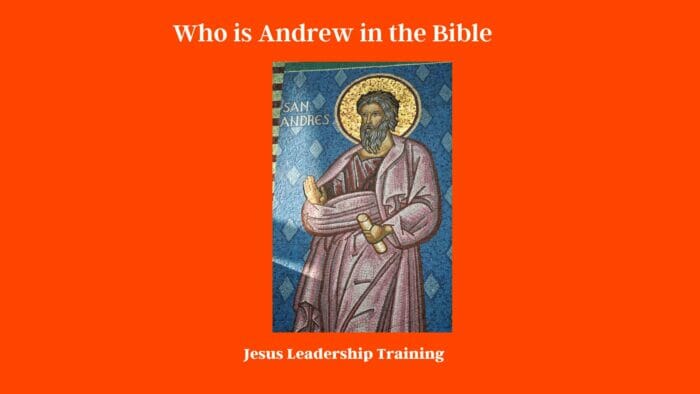Who is Andrew in the Bible – In the grand narrative of the Bible, many characters shape the path of history, their lives intertwining with prophecy and divine wisdom. Among these crucial figures stands Andrew, an Apostle who, despite not being as renowned as others like Peter or Paul, played a significant role in early Christianity. But who is Andrew in the Bible? That’s what we aim to unfold in this comprehensive piece.
Table of Contents
Who is Andrew in the Bible: A Brief Overview
Often mentioned as a footnote to his more famous brother Simon Peter, Andrew’s story provides a glimpse into the profound yet humble origins of the Christian faith. Recognized as one of the first disciples of Christ, Andrew’s narrative offers lessons in faith, discipleship, and the importance of playing one’s part in God’s grand design.
As we peel back the layers of Andrew’s story, we’ll find that there’s much more to this Apostle than meets the eye. So buckle up, as we take a journey back in time, exploring the life, teachings, and legacy of Andrew the Apostle.

Andrew’s Early Life: Born into a Family of Fishermen
Andrew, along with his more renowned brother Simon Peter, were fishermen by trade, hailing from the town of Bethsaida on the Sea of Galilee. The life of a fisherman was a humble one, filled with long hours and arduous work. But it was this very livelihood that prepared Andrew for the journey that lay ahead.
Called to Follow: Andrew’s Encounter with Jesus
One day, as Andrew and Simon Peter were casting their nets into the Sea of Galilee, Jesus approached them with a simple yet profound invitation: “Follow me, and I will make you fishers of men.” This life-altering encounter set Andrew on a path of discipleship that would shape the course of Christian history.
Unraveling the Mystery: How Many Apostles Did Jesus Have | Jesus | Disciples | Christ
Andrew: The Connecter
A consistent theme in Andrew’s story is his role as a connecter. Andrew was instrumental in introducing others to Jesus, starting with his brother Simon Peter. He also played a crucial role in the miracle of feeding the five thousand, pointing out the boy with the five loaves and two fishes.

Andrew’s Post-Resurrection Endeavors
Following Jesus’ resurrection and ascension, Andrew embarked on a mission to spread the word of Christ. According to various traditions, he traveled to several areas, including Scythia, Byzantium, and Greece.
Martyrdom and Legacy of Andrew
Despite his efforts, Andrew’s mission didn’t come without opposition. Eventually, his commitment to spreading the Christian message led to his martyrdom. Nevertheless, his legacy continues to inspire and influence Christianity to this day.

Traditions that indicate how Andrew died
Here’s a table detailing the traditional accounts regarding the death of Andrew, one of Jesus’s apostles:
| Source | Details |
|---|---|
| Early Christian Tradition | Early Christian tradition holds that Andrew was martyred by crucifixion in the city of Patras in Achaea (modern Greece). |
| Type of Cross | It is traditionally said that Andrew was crucified on an X-shaped cross, which is now known as “Saint Andrew’s Cross.” He supposedly felt unworthy to be crucified on the same type of cross as Jesus, hence the different shape. |
| Apocryphal Texts | The ‘Acts of Andrew’, an apocryphal text, also recount his martyrdom in Patras. The narrative describes him continuing to preach to onlookers even while affixed to the cross. |
| Time of Death | Although the exact date is not definitively known, most sources suggest it was during the reign of Emperor Nero, likely around 60-70 AD. |
| Veneration | Due to his manner of death, Andrew became the patron saint of several countries including Scotland and Russia. The X-shaped cross is featured prominently on their flags. |
These traditions, however, should be approached with a sense of caution as they have been passed down through apocryphal writings and Christian lore rather than canonical biblical texts.
Andrew’s Teachings and Lessons from his Life
Like all Apostles, Andrew’s story in the Bible is ripe with lessons for Christians and all who are intrigued by the richness of Biblical narratives.
Key Spiritual Lessons Drawn from the Life of Andrew
Here’s a table presenting some of the key spiritual lessons drawn from the life of Andrew, one of Jesus’s apostles:
| Spiritual Lesson | Details from Andrew’s Life |
|---|---|
| Willingness to Follow | When John the Baptist identified Jesus as the Lamb of God, Andrew immediately left to follow Jesus, demonstrating a willingness to embrace change and follow divine guidance (John 1:35-40). |
| The Value of Personal Witness | Andrew’s first action after meeting Jesus was to find his brother Simon (later known as Peter) and bring him to Jesus. This illustrates the power of personal witness in sharing faith (John 1:41-42). |
| Understanding the Significance of Small Offerings | When a large crowd needed feeding, Andrew brought a boy with five loaves and two fish to Jesus. Despite the seemingly insignificant offering, Jesus performed a miracle that fed thousands, demonstrating that no offering to God is too small or insignificant (John 6:8-9). |
| Intercession | Andrew often acted as an intermediary. For instance, some Greeks who wished to see Jesus approached Philip, who then told Andrew, and together they told Jesus (John 12:20-22). This shows the importance of interceding for others and assisting them to come to Jesus. |
| Trust in God’s Providence | Despite often being overshadowed by his brother Peter in biblical narratives, Andrew shows no signs of jealousy or resentment. This attitude demonstrates trust in God’s plan and the understanding that every role in the Kingdom of God is important. |
Each of these lessons from Andrew’s life underscores the value of faith, humility, personal witness, and the power of seemingly small contributions in the broader context of God’s plan.
Humble Beginnings Can Lead to Great Things
Andrew’s life serves as a potent reminder that humble beginnings can lead to incredible spiritual journeys. He may have started as a humble fisherman, but his willingness to follow Jesus turned him into a fisher of men.
Being a Connector Can Make Significant Impact
Another key takeaway from Andrew’s life is the importance of connecting people. His role in introducing others to Jesus shows how our connections can lead to monumental spiritual transformations.
Sacrifice in the Name of Faith
Andrew’s martyrdom is a stark illustration of sacrifice in the name of faith. His willingness to die for his beliefs challenges us to consider the depth of our own faith and the sacrifices we’re willing to make.
Facts we know about Andrew
Here’s a table detailing what we know about Andrew, one of the twelve disciples of Jesus:
| Facts About Andrew | Details |
|---|---|
| Early Life | Andrew was a fisherman by trade, born in Bethsaida. He was the brother of Simon Peter (Matthew 4:18). |
| Discipleship | Andrew was originally a disciple of John the Baptist. After hearing John’s testimony, he followed Jesus and recognized Him as the Messiah (John 1:35-40). |
| Apostle | Andrew was one of the first disciples Jesus called to follow him. He was part of the inner circle of Jesus’ disciples and is often listed among the first four apostles in the New Testament (Matthew 10:2-4). |
| Evangelism | Andrew introduced his brother Simon Peter to Jesus (John 1:41-42), demonstrating his role in bringing others to Christ. |
| Feeding the Five Thousand | Andrew is specifically mentioned in the miracle of the feeding of the five thousand, bringing a boy with loaves and fish to Jesus (John 6:8-9). |
| Relationship with Greeks | Andrew, along with Philip, was approached by Greeks who wanted to see Jesus, indicating that he may have had a special ministry to Greeks (John 12:20-22). |
| Post-Resurrection | Andrew was present at the Great Commission (Matthew 28:16-20) and the Ascension (Acts 1:6-11). His specific acts post-resurrection are not detailed in the Bible, but he is believed to have preached the gospel in various regions, according to early Church traditions. |
It is worth noting that beyond the New Testament, information about Andrew’s life and ministry comes from early Church tradition and apocryphal writings, which may vary in historical reliability.
What is the Meaning of the Name Andrew
The biblical name Andrew is a popular name throughout history, and its origins are steeped in a rich and fascinating history. The etymology of the name Andrew can be traced back to several different languages.
Origin
The name Andrew is derived from the Greek name Andreas, which is derived from the word andros, meaning “man”. The name Andrew has been found in various languages, including Hebrew, Greek, Aramaic, and Latin.
Hebrew
In Hebrew, the name Andrew is known as Ananias. The name Ananias is derived from the Hebrew word anah, which means “grace”. This is associated with the biblical story of Ananias and Sapphira in Acts 5.
Greek
The name Andreas is derived from the Greek word andros, meaning “man”. This name was popularized by the Greek philosopher and historian Aristotle, who used it in his writings.
Aramaic
In Aramaic, the name Andrew is known as Ananias. This is derived from the Aramaic word anan, which means “answers”. This likely refers to the biblical story of Ananias and Sapphira in Acts 5.
Latin
In Latin, the name Andrew is known as Andreus. This is derived from the Latin word andre, which means “strong”. This likely refers to the biblical story of Andrew the Apostle, who was a strong leader and follower of Jesus.
Overall, the etymology of the name Andrew is steeped in a rich and fascinating history. The name has been found in various languages, including Hebrew, Greek, Aramaic, and Latin. Each of these languages has its own meaning associated with the name, making it a popular name throughout history.
Names that come from the Biblical name of Andrew
Here’s a table presenting a few variants and names derived from the biblical name “Andrew”:
| Language/Culture | Variant of “Andrew” |
|---|---|
| English | Andy, Drew |
| Scottish | Aindrea, Aindreas |
| Irish | Aindriú |
| Welsh | Andras |
| French | André |
| Italian | Andrea |
| Spanish | Andrés |
| Portuguese | André |
| Dutch | Andries |
| German | Andreas |
| Greek | Andreas, Andros |
| Russian | Andrei, Andrey |
| Scandinavian | Anders, Andreas |
| Polish | Andrzej |
| Hungarian | András, Endre |
| Arabic | Andraos |
The name “Andrew” is widely used across many cultures, and its variations reflect this broad usage. Each of these names maintains a connection to the original Greek “Andreas,” which means “manly” or “brave”.
Where the Bible and History show Andrew Spread the Gospel
The Bible doesn’t provide a clear account of where Apostle Andrew spread the gospel after the ascension of Jesus. However, various historical and traditional accounts suggest that he traveled to different regions to preach Christianity. It should be noted that these accounts are based on tradition and church histories, and thus, their historical accuracy may vary.
| Region/Country | Source/Details |
|---|---|
| Scythia | Early church histories and traditions suggest that Andrew traveled to Scythia, a region that covers present-day southern Russia, Ukraine, and Kazakhstan. |
| Greece | Tradition holds that Andrew preached in Achaea in Greece, particularly in the city of Patras, where he is believed to have been martyred. |
| Asia Minor (Modern-day Turkey) | Some accounts suggest that Andrew preached in Asia Minor. |
| Byzantium (Modern-day Istanbul) | According to tradition, Andrew founded the See of Byzantium in AD 38, and ordained the first bishop of Byzantium. |
| Georgia | Some Georgian traditions state that the first preacher of Christianity in Georgia was Andrew. |
Please remember that these accounts are not found in the canonical New Testament and the details about Andrew’s journeys are not universally agreed upon.
Frequently Asked Questions About Andrew the Apostle
- Why is Andrew considered the first Apostle?
Andrew is often considered the first Apostle because he was among the first to follow Jesus. Before joining Jesus, Andrew was a disciple of John the Baptist and transitioned to following Jesus after hearing John’s endorsement of Him. - How did Andrew die?
According to tradition, Andrew was martyred in Patras, Greece, on an X-shaped cross, which is now known as “St. Andrew’s cross.” - Why is Andrew the patron saint of Scotland?
Andrew is the patron saint of Scotland because of a legend that some of his relics were brought to Scotland by Saint Regulus. The Scottish flag, the Saltire, is based on the X-shaped cross upon which Andrew was crucified. - What is Andrew known for in the Bible?
Andrew is known in the Bible for his role as a disciple of Jesus, the brother of Simon Peter, and for his role as a ‘connector’ introducing others to Jesus. - What was Andrew’s profession?
Before becoming an Apostle, Andrew was a fisherman by profession, a common trade in his hometown of Bethsaida. - What lessons can we learn from Andrew’s life?
Lessons from Andrew’s life include the importance of humble beginnings, the power of connection in spreading faith, and the willingness to sacrifice for one’s beliefs.
Final Thoughts – Who is Andrew in the Bible
As we delve into the question, “Who is Andrew in the Bible?”, we encounter a man who lived in the shadow of his more famous brother yet managed to leave an indelible mark on Christianity. Andrew’s story serves as a testament to the extraordinary impact a humble fisherman can make when he answers the call to discipleship. His life continues to inspire believers, reminding us of the powerful influence we can exert when we connect others to a life-transforming faith.



